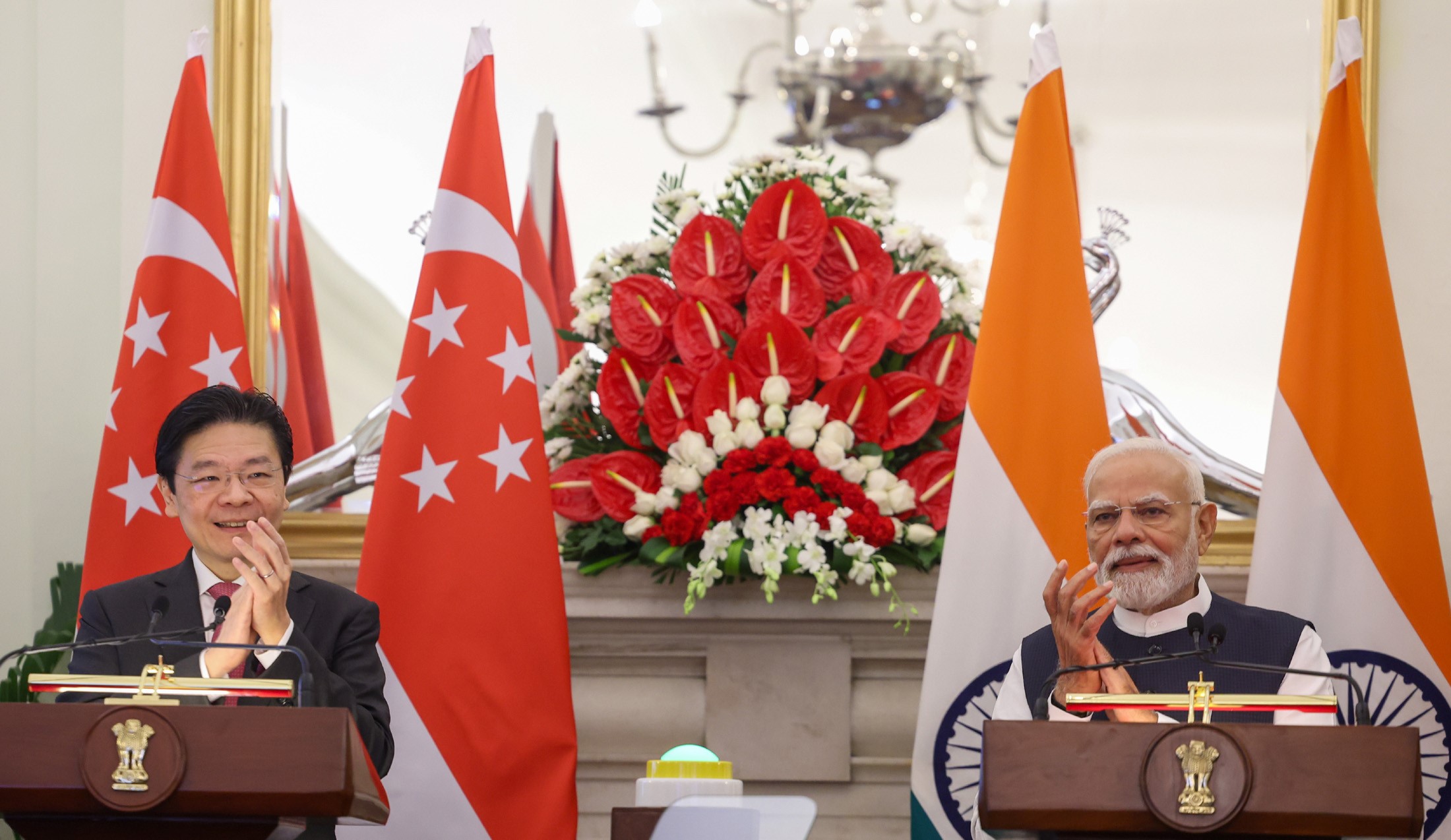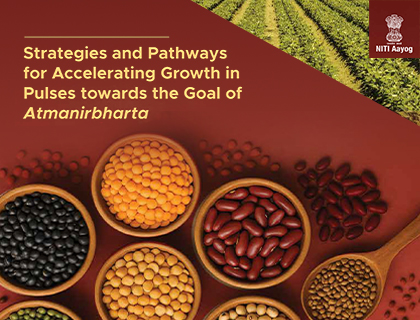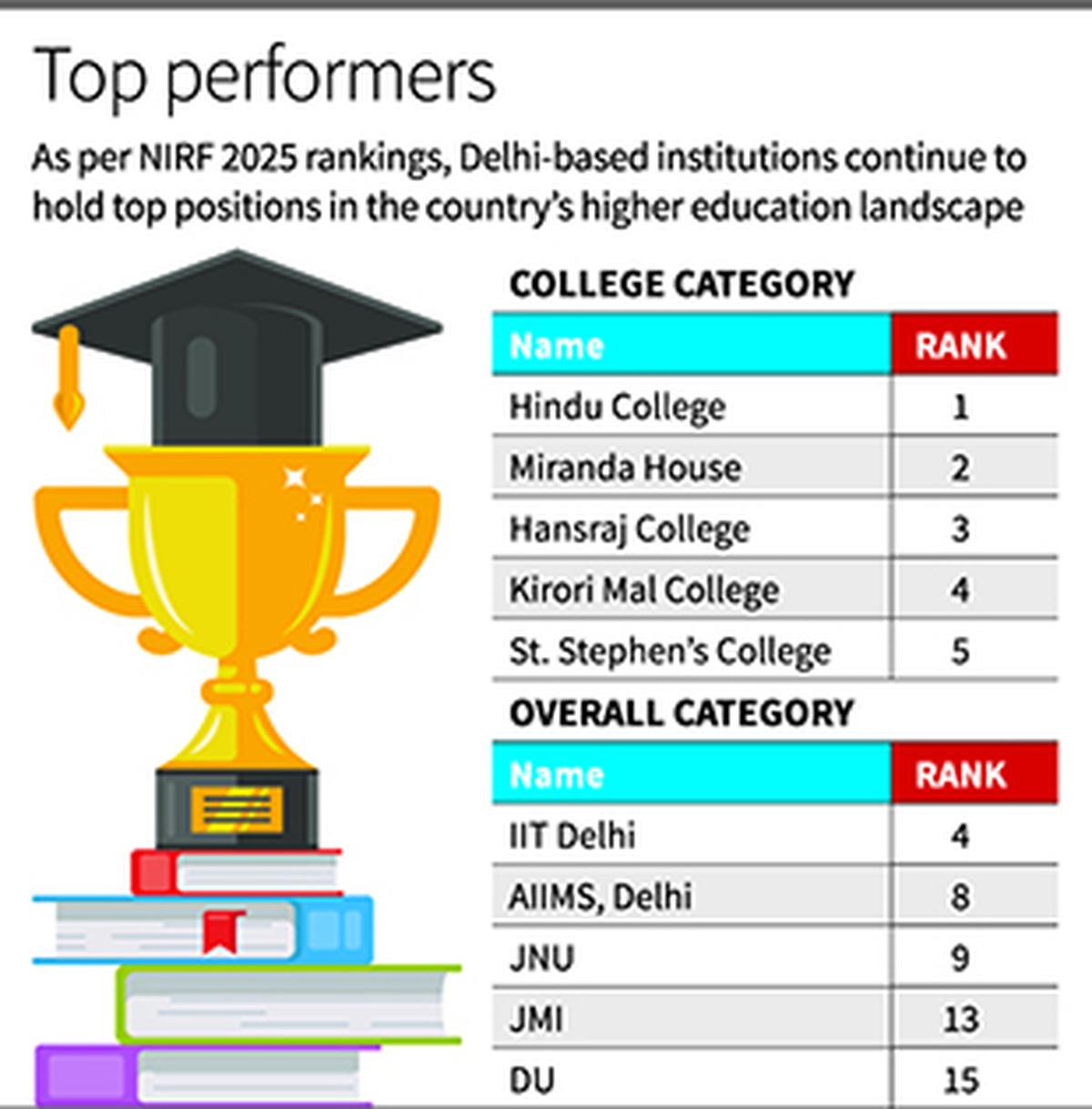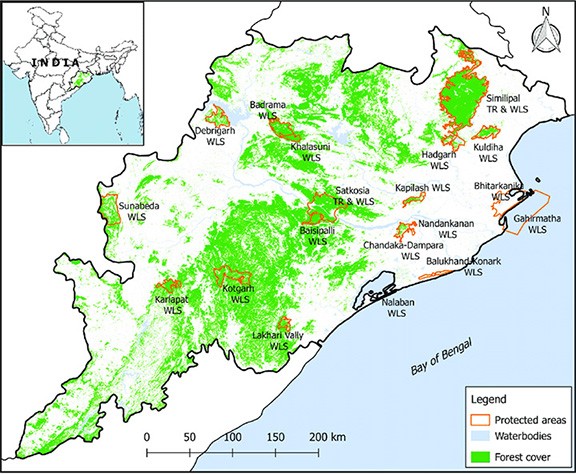India–Singapore Comprehensive Strategic Partnership (CSP): 2025 Roadmap

- 10 Sep 2025
In News:
The visit of Singapore Prime Minister Lawrence Wong to India in September 2025 marked 60 years of diplomatic relations and culminated in the adoption of a forward-looking Comprehensive Strategic Partnership (CSP) Roadmap. This elevates bilateral ties beyond trade to encompass technology, security, sustainability, and people-centric cooperation, reinforcing Singapore’s role as a vital partner in India’s Act East Policy and Indo-Pacific vision.
What is CSP?
- The Comprehensive Strategic Partnership (CSP) is the highest level of bilateral engagement between India and Singapore.
- It was elevated from a Strategic Partnership in 2015, and deepened further in 2025 through the adoption of a roadmap across eight key sectors.
Eight-Pillar Cooperation Framework
- Economic Cooperation
- Review of Comprehensive Economic Cooperation Agreement (CECA) and ASEAN-India Trade in Goods Agreement (AITIGA) in 2025.
- Partnership in semiconductors: Singapore produces 10% of global semiconductors and 20% of semiconductor equipment—key to India’s domestic chip manufacturing ambitions.
- Cooperation in industrial parks, sustainable manufacturing, capital market connectivity (NSE-IFSC-SGX GIFT Connect), and space collaboration.
- Skills Development
- Establishment of the National Centre of Excellence for Advanced Manufacturing in Chennai.
- Joint efforts in Technical and Vocational Education and Training (TVET), skill certification, train-the-trainers programmes, and nursing skill cooperation (expansion of the Singapore–Assam model).
- Digitalisation
- Expansion of UPI–PayNow linkage for seamless cross-border payments.
- Collaboration in fintech, cybersecurity, AI applications (healthcare, agriculture), start-up ecosystems, and adoption of TradeTrust for e-Bills of Lading in trade documentation.
- Sustainability & Green Growth
- Cooperation in green hydrogen, ammonia, and civil nuclear energy.
- Joint climate initiatives under Article 6.2 of the Paris Agreement.
- Collaboration in the International Solar Alliance (ISA) and Global Biofuels Alliance.
- Partnership in food security, agricultural exports, and water management.
- Connectivity
- Establishment of an India–Singapore Green and Digital Shipping Corridor linking major Indian ports with Singapore.
- Knowledge-sharing in aviation (air services agreement, sustainable aviation fuel, MRO collaboration).
- Healthcare & Medicine
- MoU on Health and Medicine: digital health, maternal and child health, disease surveillance, and medical R&D.
- Nursing cooperation and skills training to enhance employability in Singapore.
- People-to-People & Cultural Exchanges
- Student and professional exchanges, parliamentary engagement, think tank linkages, and public service training.
- Promotion of cultural heritage and maritime history collaborations.
- Defence& Security
- Enhanced military cooperation through SIMBEX 2025 and other tri-service exercises.
- Collaboration on defence technology (AI, automation, unmanned systems, quantum computing).
- Maritime security including submarine rescue cooperation and regional patrols.
- Strengthened counter-terrorism efforts via FATF and other multilateral mechanisms.
- Singapore acknowledged India’s interest in the Malacca Straits Patrol (MSP); India’s Andaman & Nicobar Command enhances regional maritime domain awareness.
Strategic Significance
- Positions Singapore as India’s gateway to Southeast Asia and the broader Indo-Pacific.
- Enhances regional security architecture aligned with ASEAN principles.
- Demonstrates how middle powers can address global uncertainties through technology partnerships, defence collaboration, and sustainable growth initiatives.
India’s Path to Atmanirbharta in Millets

- 10 Sep 2025
In News:
The NITI Aayog report “Strategies and Pathways for Accelerating Growth in Pulses towards the Goal of Atmanirbharta” also provides broader lessons for achieving self-reliance in other food crops like millets, which face similar challenges of productivity, market stability, and sustainability.
Current Status of Millets in India
- Global Leadership: India contributes nearly 41% of world millet output (~16 million tonnes annually), making it the largest producer.
- Regional Spread: Five states—Rajasthan, Maharashtra, Karnataka, Uttar Pradesh, and Madhya Pradesh—produce over 80% of India’s millets.
- Consumption Decline: Per capita consumption has dropped from 32 kg/year in the 1960s to ~4 kg/year today, largely replaced by rice and wheat due to PDS bias.
- Exports: In 2022–23, India exported 1.8 million tonnes, mainly to UAE, Nepal, and Saudi Arabia, indicating rising global demand.
- Policy Push: The Union Budget 2023–24 renamed millets as “Shree Anna”, earmarking resources for research, processing, and marketing.
Importance of Millets
- Nutritional Security: Rich in iron, calcium, fiber, and proteins, helping fight malnutrition and anemia.
- Climate Resilience: Require 70% less water than rice and withstand drought, making them suitable for rainfed regions.
- Farmer Livelihoods: Low-input crops reduce reliance on irrigation and fertilizers, benefiting smallholders.
- Food Security: Inclusion in Mid-Day Meals, ICDS, and PDS enhances nutrition for vulnerable groups.
- Global Branding: India’s “Shree Anna” campaign has positioned millets as a superfood and strengthened agri-diplomacy.
Initiatives Taken
- NFSM-Millets: Expands area under millets, provides quality seed, and boosts productivity.
- Shree Anna Mission (2023): A six-year plan for millet research, processing, branding, and market integration.
- State Schemes: Karnataka’s Ksheera Bhagya included millets in school meals.
- International Recognition: India led the UNGA resolution declaring 2023 as International Year of Millets.
- Export Promotion: APEDA supports branding, GI tagging, and product exports to West Asia, US, and EU.
Challenges
- Consumer Preference Shift: Rice and wheat dominate diets due to PDS subsidies and cooking convenience.
- Low Productivity: Millet yields (~1.2 t/ha) remain below rice/wheat due to limited R&D and weak seed systems.
- Weak Market Linkages: Fragmented value chains, inadequate FPO presence, and absence of MSP-backed assured procurement.
- Post-Harvest Constraints: Poor processing/storage technologies and limited millet-based food industry.
- Policy Bias: NFSA subsidies for rice/wheat discourage millet adoption in rainfed belts.
Strategic Framework for Atmanirbharta
- Horizontal Expansion: Cultivate millets in rice fallows and degraded lands, especially in Eastern India.
- Vertical Expansion: Develop high-yielding, bio-fortified, climate-resilient varieties with robust seed systems.
- Cluster-Based Model: District-wise crop cluster strategy for focused interventions.
- Value Chain Integration: Establish processing hubs, branding centers, and FPO-led aggregation.
- Climate-Smart Farming: Promote organic and water-efficient millet practices, aligning with SDGs and climate goals.
National Institutional Ranking Framework

- 10 Sep 2025
In News:
The Ministry of Education has released the India Rankings 2025 under the National Institutional Ranking Framework (NIRF), first launched in 2015 to provide a transparent, data-driven methodology for ranking higher education institutions (HEIs).
Background
- Introduced in 2015 by the Ministry of Education (then MHRD).
- First rankings released in 2016 with one category (Universities) and three domains (Engineering, Management, Pharmacy).
- Now expanded to 9 categories and 8 subject domains, with SDG-based rankings introduced in 2025.
- Aim: To benchmark quality, ensure accountability, guide students/parents, and align with NEP 2020 goals of making India a knowledge superpower by 2047.
Parameters of NIRF (Weightage)
- Teaching, Learning & Resources (30%)
- Research & Professional Practice (30%)
- Graduation Outcomes (20%)
- Outreach & Inclusivity (10%)
- Perception (10%)
- Total of 19 sub-parameters used.
- Data sourced from institutions and third parties like Scopus, Web of Science, Derwent Innovation for publications, citations, and patents.
Participation & Growth
- 2025: 7,692 unique institutions applied (14,163 submissions), compared to 2,426 in 2016 – a 217% rise in participants and 297% rise in applications.
- Rankings now cover 17 categories, including overall, universities, colleges, research institutions, medical, dental, law, pharmacy, management, architecture & planning, agriculture, open universities, skill universities, state public universities, innovation, and SDGs.
Key Highlights of 2025 Rankings
- IIT Madras: Retains 1st rank in Overall category for the 7th year and Engineering for the 10th year. Also topped Innovation and SDGs categories.
- IISc Bengaluru: Ranked 1st among Universities for the 10th year; also leads in Research Institutions for the 5th year.
- IIM Ahmedabad: Topped Management for the 6th consecutive year.
- AIIMS Delhi: 1st in Medical for the 8th year; also ranked 8th in Overall. Additionally topped Dental for the first time.
- Jamia Hamdard (Delhi): 1st in Pharmacy for the 2nd year.
- IIT Roorkee: 1st in Architecture & Planning for the 5th consecutive year.
- NLSIU Bengaluru: Retains 1st position in Law for the 8th year.
- Hindu College (Delhi University): 1st among Colleges for the 2nd year, displacing Miranda House. Six of the top ten colleges are from Delhi.
- Indian Agricultural Research Institute (Delhi): 1st in Agriculture & Allied Sectors for the 3rd year.
- IGNOU (Delhi): 1st in Open Universities category for the 2nd year.
- Symbiosis Skill & Professional University (Pune): 1st in Skill Universities for the 2nd year.
- Jadavpur University (Kolkata): 1st in State Public Universities (introduced in 2024).
Significance
- NIRF has evolved into a credible national benchmark for higher education, enhancing global competitiveness, transparency, and inclusivity.
- With new categories such as Innovation, Skill Universities, and SDG rankings, it reflects India’s effort to link education with sustainability, entrepreneurship, and national development goals under NEP 2020.
- Participation trends demonstrate growing institutional acceptance of NIRF as a fair and transparent ranking mechanism.
Acanthamoeba

- 10 Sep 2025
In News:
Recent studies have revealed that Acanthamoeba, a free-living amoeba, is more widespread in Kerala’s waterbodies than previously believed. This raises significant public health concerns, especially due to its ability to cause severe and often fatal infections.
About Acanthamoeba
- Nature: A single-celled, free-living amoeba found in water, soil, and dust.
- Habitats: Frequently detected in swimming pools, hot tubs, household wells, drinking water systems, humidifiers, and HVAC (heating, ventilation, and air conditioning) systems.
- Mode of Transmission: Enters the human body through skin wounds, inhalation via lungs/nasal cavity, or eye exposure (notably among contact lens users).
Types of Infections
- Granulomatous Amebic Encephalitis (GAE): Affects the brain; almost always fatal.
- Cutaneous Acanthamoebiasis: Skin infection through wounds.
- Acanthamoeba Rhinosinusitis: Infection of the nasal cavity and sinuses.
- Acanthamoeba Keratitis: Serious eye infection, often in healthy individuals and contact lens users; may lead to permanent vision loss.
Kerala Case Study
- In 2013, research from the Regional Institute of Ophthalmology (Kerala) identified that several cases of non-healing corneal ulcers were due to Acanthamoeba keratitis, traced back to household wells as the infection source.
- Current findings indicate that Acanthamoeba is more widespread in Kerala’s natural and man-made waterbodies than earlier thought, heightening risks of waterborne and eye-related infections.
Significance
- The rise of Acanthamoeba-related keratitis underlines the need for safe water practices, improved eye hygiene among contact lens users, and awareness of rare pathogens.
- Its resilience across diverse environments makes it a public health challenge, especially in regions dependent on household wells and untreated water sources.
Debrigarh Wildlife Sanctuary

- 10 Sep 2025
In News:
Odisha’s Debrigarh Wildlife Sanctuary has recently been approved by the National Tiger Conservation Authority (NTCA) to become India’s newest tiger reserve. This marks a significant ecological achievement rooted in community participation, innovative eco-tourism, and conservation success.
Location and Geography
- Situated in western Odisha, near Sambalpur and Bargarh district, Debrigarh is bordered by the Hirakud Reservoir—a Ramsar-tagged wetland and part of the Mahanadi River system.
- The Hirakud Dam, the world’s longest earthen dam, lies adjacent to the sanctuary.
- Spread over 804 sq km, it includes around 347 sq km of core area, encompassing forests, grasslands, and wetlands, making it a unique amphi-terrestrial ecosystem.
Historical Significance
- The rugged terrain of Debrigarh was a strategic base for freedom fighter Veer Surendra Sai during his armed resistance against British colonial rule.
- Sites like Bara Bakra/Barapathara remain important heritage landmarks within the sanctuary.
Flora and Fauna
- Vegetation: Dominated by mixed and dry deciduous forests, with species such as Sal, Asana, Bija, Aanla, and Dhaura.
- Mammals: Indian bison (gaur), sambar deer, wild boar, chousingha (four-horned antelope), leopards, sloth bears, and wild dogs.
- Avifauna: Over 300 bird species, including 120 migratory species such as crested serpent eagle, drongo, tree pie, flower peckers, and white-eye oriental.
Eco-Tourism and Innovation
- Debrigarh is home to India’s first dark sky tourism hub, offering stargazing facilities.
- Adventure tourism includes safaris (53 vehicles), kayaking, cycling, and birding trails, designed with minimal ecological footprint.
Conservation and Community Model
- Declared a sanctuary in 1985 and upgraded to a tiger reserve in 2025.
- A community-led model: Over 400 families voluntarily relocated with rehabilitation packages; 155 villages actively participate in conservation and eco-tourism activities.
- Wildlife success: Expansion of prey base, increase in gaur population, and nearly 40% of herds comprising newborns, reflecting ecosystem recovery.
Significance
Debrigarh exemplifies a national model of integrated conservation, blending:
- Biodiversity protection (tiger reserve status, prey base recovery).
- Cultural heritage (legacy of Veer Surendra Sai).
- Sustainable eco-tourism (dark sky hub, water- and land-based safaris).
- Community participation (relocation and livelihood integration).
Its success offers a replicable blueprint for wildlife conservation across India, highlighting how ecological protection, heritage, and rural livelihoods can be balanced under one framework.
